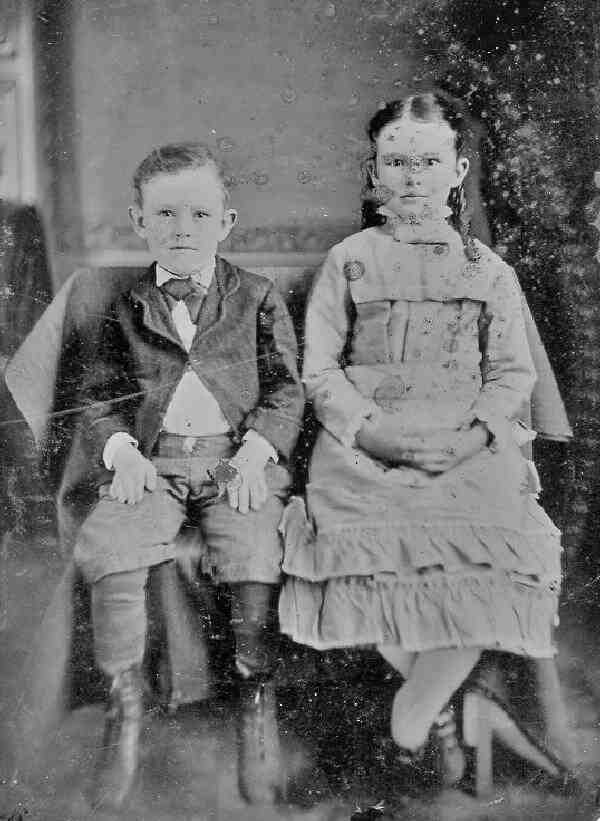
Closed-toe Sandals: Chronological Periods

Figure 1.--Here we see two Canadian children in a tin-type portrait. It is undated , but we would guess was taken in the 1870s. Notice the multiple strap shoes worn by the girl. We have also noted boys wearing these multiple-strap shoes, but usually younger boys. We are not sure whast these shoes were called in the 1870s, but by the late 19th cebntury we note them being called sandals.
|
|
HBC does not yet have a developed chronology of sandals or specifically of closed-toe sandals. We will begin to build one here. We note single-bar shoes in the early 19th centiry as well as in earlier historical periods. We are not sure what these shoes were called in the early 19th century. These shoes were all single-bar shoes in the early 20th century. After mid-century we begin to see shoes with multiple straps. Here there was a vide variety. We do not note any of these shoes with center straps. There are some complications here. We are not entirely sure what this footwear was called in the early and mid-19th century. We note sandal being used in the late 19th century. This appears to have been a purely stylistic term referring to to the open structure and straps with none of the modern connotations of a casual, play shoe. Modern sandal styles appeared after the turn of the 20th century, but the term sandal continued to be used for dress strap shoes well into the 20th century. We note the double-strap shoe appeared in the early 1900s. We are not sure when the single-bar, "T"-strap school sandal first appeared.
Early Periods
We have noted footwear styles that might be called closed-toe sandls in earlier periods dating back to ancient times. A good example is Roman footwear. We are not going to detail these historical examples here. This is because these examples were not sandals in the modern sence of a casual, play shoe. This is a conotation which only developed in the 20th century. Rather they would be better defined as a strap shoe. We will thus develop this in the strap shoe chronology.
The 19th Century
We have noted strap shoes in the 19th century, but these were more of a dress shoe than a sandal. We note portraits of boys wearing closed-toe sandals throughout the 19th century as well as earlier historical periods. We are not sure what these shoes were called in the early 19th century. These shoes were all single-bar shoes in the early 20th century. After mid-century we begin to see shoes with multiple straps. Here there was a vide variety. We do not note any of these shoes with center straps. There are some complications here. We are not entirely sure what this footwear was called in the early and mid-19th century. We note sandal being used in the late 19th century. This appears to have been a purely stylistic term referring to to the open structure and straps with none of the modern connotations of a casual, play shoe.
A good example is a infant German boy about 1870. Another good example is an unidentified American boy in the 1870s. We have noted several sandal-like shoes in the 19th century, but they seem to be mostly formal dress shoes. There are many images of boys and girls wearing strap shoes, both single-bar and multi-strap shoes. We are not sure, however, if it is correct to refer to this footwear as a sandal in the modern sence. We are also not sure of the conventions involved. We are not sure how commonly the term sandal was used in the 19th century. We have seen it used. It seems to have refeered to shoes with straps. We have not noted it being used in the sence of a casual, play shoe until the 20th century. We note a few school images, showing mostly girls wearing sandals. An example in America is the Omarga School in 1882. Most of the images we have are formal portraits. An example is Arthur Franz (1898). The perponderance of these formal portraits may reflect the fact that informal snapshots are still quite rare even in the 1890s.
Closed toe sandals appear to have appeared in England, America, and other countries at the turn of the 20th century. We have a larger archive of American impages at the turn of the century, but believe they were also common in Europe. They become more common in the 1900s. They appear in both formal portraits and informal snapshots. We note catalog advertisements in the early 20th century, but are not sure when the first ads appeared. HBC is unsure at this time why the sandal suddenly proved popular in the early 20th century. Perhaps it was part of the overall shift toward increased informality in dress. Chronology is importan not only in the development of closed-toe sandals, but also in terms of popularity as well as age and gender conventions.
HBC

Navigate the Boys' Historical Clothing Web Site:
[Return to Main closed-toe sandal chronology page]
[Introduction]
[Activities]
[Biographies]
[Chronology]
[Clothing styles]
[Countries]
[Bibliographies]
[Contributions]
[Essays]
[FAQs]
[Glossaries]
[Satellites]
[Tools]
[Boys' Clothing Home]
Created: 9:16 PM 8/29/2005
Last updated: 9:16 PM 8/29/2005



